![]()
Issue Number 9 : March 1997
|
|
Issue Number 9 : March 1997 |
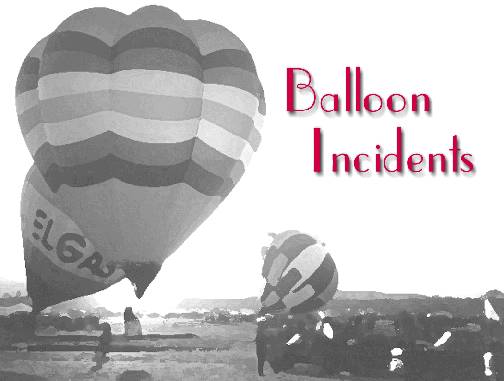
by Allen Amsbaugh
Man's first venture into the air was in a hot air balloon invented by the Montgolfier brothers, papermakers of Annonay, France. The Montgolfier balloon, sponsored by Louis XVI, was flown from the Bois de Boulogne in Paris on November 21, 1783. In attendance were many notables, including Benjamin Franklin. When asked by a skeptic, "Of what use is it?," Ambassador Franklin is reported to have said, "Of what use is a newborn baby?"
Professor Charles, inventor of the gas balloon, was working concurrently with the Montgolfier brothers, and in direct competition for the support of the king. His approach was a balloon filled with newly discovered hydrogen obtained from disassociation of the elements composing water. Professor Charles' creation, the Charliere balloon, flew from the Tuileries on December 1, 1783, and the Space Race was on!
Within a very few years, a third type of balloon was flown by Pilatre de Rozier, also in France. The Rozier balloon combined hot air and hydrogen; a hydrogen envelope inside a hot air envelope was heated so that less valving and ballasting were necessary to maintain altitude control. This soon proved to be dangerous, and the Roziere-type balloon was forgotten until helium became readily available.
All three types of balloons, or aerostats - the Mongolfiere, Charliere, and Roziere - are in use today. Propane burners have replaced wood, straw, and dung in the hot air, or Mongolfiere balloons. Helium, ammonia, city gas, and hydrogen are the lifting gasses used in gas, or Charliere balloons, while Roziere balloons now use a helium inner envelope, with a surrounding hot air envelope heated by propane.
The renaissance of hot air ballooning developed under the guidance of Ed Yost in Sioux Falls, SD, in the early 1960s under a U.S. Navy contract with General Mills. The Yost-General Mills product proved to be more valuable for recreation than for military use, and sport hot air ballooning was reborn. There has since been a steady growth of ballooning in the United States and around the world, and balloons can be seen flying every day. Many flights are in competitive events and rallies. Balloons are also used commercially to give sightseeing rides, and as flying billboards to advertise many products.
More and more balloonists, or aeronauts, have become aware of and are using the Aviation Safety Reporting System (ASRS) to report safety concerns or perceived violations. A review was performed of 109 ballooning incidents reported to the ASRS from 1990 to 1994. There were no reports from gas balloon or airship flights, possibly a reflection of the low level of activity in these sectors. Also, there were no reports from any of the highly publicized long distance or altitude flights. This may reflect the extra caution, care, and planning that goes into these flights, as opposed to the casual weekend sport flight or the flights taken by commercial pilots.
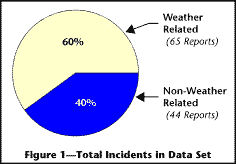 Most
of the reporters state that weather and winds were the cause of their incidents.
These adverse wind and weather conditions are often found only in a very small
area and thus may be termed micro-meteorological conditions. Weather briefers
tasked with providing area and airport-specific aviation forecasts may be unable
to provide micro-meteorological forecasts or reports about conditions of concern
to the balloonist. Consequently, most observation is done by the balloonist
on the spot after getting all available official reports. This often leads to
surprises, incidents, accidents, and sometimes, to tragedy.
Most
of the reporters state that weather and winds were the cause of their incidents.
These adverse wind and weather conditions are often found only in a very small
area and thus may be termed micro-meteorological conditions. Weather briefers
tasked with providing area and airport-specific aviation forecasts may be unable
to provide micro-meteorological forecasts or reports about conditions of concern
to the balloonist. Consequently, most observation is done by the balloonist
on the spot after getting all available official reports. This often leads to
surprises, incidents, accidents, and sometimes, to tragedy.
Sixty-five of the 109 reports (60 %) listed weather factors as the cause of the incident. (See Figure 1.)
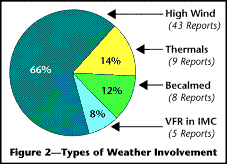 As
may be seen in Figure 2 at right, forty-three of the weather-involved reporters
(66 %) listed unforecast increasing winds as their problem. Nine reports attributed
their difficulties to thermals, or other downdrafts, forcing the balloon into
the ground. An additional eight reports listed becoming becalmed as the source
of their dilemma - not enough wind can be almost as hazardous as too much. One
aeronaut became becalmed over trees at sunset, and pulled himself to a clearing
by using the treetops. Finally, five reports were received from pilots who found
themselves VFR in IMC due to fog or fast-forming clouds underneath.
As
may be seen in Figure 2 at right, forty-three of the weather-involved reporters
(66 %) listed unforecast increasing winds as their problem. Nine reports attributed
their difficulties to thermals, or other downdrafts, forcing the balloon into
the ground. An additional eight reports listed becoming becalmed as the source
of their dilemma - not enough wind can be almost as hazardous as too much. One
aeronaut became becalmed over trees at sunset, and pulled himself to a clearing
by using the treetops. Finally, five reports were received from pilots who found
themselves VFR in IMC due to fog or fast-forming clouds underneath.
In truth, probably all of the balloon incidents could be considered weather related, as low-level flights to find suitable landing sites, landing in residential areas, and hard landings are usually caused by winds that are not favorable to the balloonist. Even some of the ground incidents undoubtedly involved unreported weather factors.
Eleven of the incidents reported involved airspace violations by aeronauts who found themselves inside the edge of Class "B," "C," or "D" airspace without proper radio contact due to a wind shift, faulty or no radio, or faulty navigation. Two aeronauts were intercepted by Air National Guard F-16s while in R-5503. The balloons were flying legally; it was the fighters who were in the airspace early and no NOTAM had been issued.
Midair collisions between balloons accounted for nine of the incidents, with five reporting damage, and one reporting an injury. Most balloon midair collisions are of the "kiss" variety where there is very little relative velocity. Reports concerning damage and injury were of the variety where the lower balloon did not observe common-sense rules in a crowded situation. In one incident, the lower pilot climbed rapidly into a balloon above. The balloon below has the right-of-way because of the lack of visibility, but this does not allow the lower balloon to climb rapidly. In an attempt to preclude this type of mishap, most balloon-meets limit the climb and descent rates to 200 feet per minute.
Six of the reports were from air carrier pilots who encountered balloons in "their" airspace. The gist of their reports was that they were loath to share the airspace and were surprised by the presence of the balloons.
Seventeen of the reported incidents concerned flights into power lines, the one incident which causes the most fatalities in ballooning. In one third of these incidents, the reporters stated that the power lines were obscured in trees. More than half reported minor damage, and three reported injuries.
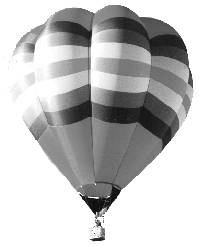 There have been other reported injuries,
including two broken ankles, to passengers who were not wearing proper footwear
in a "ride" balloon. Another ASRS incident record describes one of
the more serious types of incidents when working with balloons or airships -
attempting to hold the aerostat down by hanging onto a line or the exterior
of the basket. In this instance, a crewman lost his grip and fell, breaking
an arm and an ankle. No one should ever let
his or her feet leave the ground when handling a lighter-than-air vehicle.
There have been other reported injuries,
including two broken ankles, to passengers who were not wearing proper footwear
in a "ride" balloon. Another ASRS incident record describes one of
the more serious types of incidents when working with balloons or airships -
attempting to hold the aerostat down by hanging onto a line or the exterior
of the basket. In this instance, a crewman lost his grip and fell, breaking
an arm and an ankle. No one should ever let
his or her feet leave the ground when handling a lighter-than-air vehicle.
One of the problems aeronauts find in almost every flight is the notion, "If you're having fun, or doing something unusual, it must be illegal!" This attitude seems to be pervasive among unknowledgeable observers. One reporter describes a balloon landing on a boat in a lake after becoming becalmed. The aeronaut and his balloon were successfully retrieved, only to find themselves on the evening news! Fortunately, the local FSDO was able to laugh with the aeronaut over this. In another incident, a balloon was seen flying through the tops of some trees, an accepted practice to slow forward velocity, and then landed safely in a vacant area. The observer was the local fire chief who "called out the artillery."
Four incidents related to livestock on the ground. One involved a typical "balloon dog" that got upset, then barked and upset its owner. In another report, the balloon spooked some cattle, and in another incident, the balloon flew low over an aviary that was not on the pilot's chart. The most serious incident was the alleged spooking of a horse. Its rider was thrown and suffered a broken arm.
Balloon fatalities can also result from a propane leak, either in flight or on the ground. Three reporters listed a propane leak - two in the air and one on the ground. In one incident there was damage, and the other resulted in injury. In a fourth incident, an aeronaut reported fuel contamination of an unknown source.
Of the 109 incidents studied, 25 reported damage to their balloon or to another balloon; 13 reported injuries; and 25 reported official action taken, mostly by local law enforcement or fire departments.
Table 1 (below) lists the numbers and percentages of incidents reported in the 109 reports reviewed for this article.
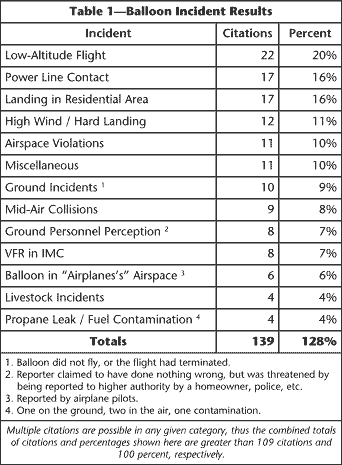
Reading these incident reports reminds one that ballooning can be a hazardous sport, but there are actually few injuries and little damage. Nonetheless, the following suggestions may help reduce the potential for incident:
For additional information, readers can reference the following books used in preparation of this article.
The Eagle Aloft - Two Centuries of the Balloon in America, Tom D. Crouch, Smithsonian Institution Press, Washington, DC, 1983
Astra Castra, Experiments and Adventures in the Atmosphere, Hatton Tuznor, Chapman and Hall, London, 1865
Picture Credits: The stylized photographs that appears in this article are the author's balloon.
|
Reproduction and redistribution of ASRS Directline articles is not only permitted--it is encouraged. We ask that you give attibution to the Aviation Safety Reporting System (ASRS), to ASRS Directline, and of course, to the authors of each article. |